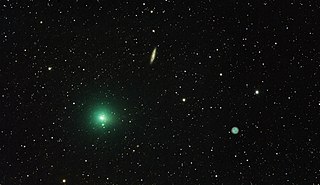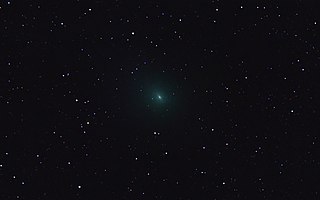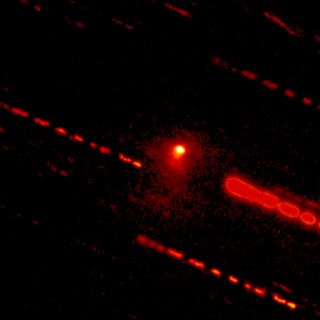
4015 Wilson–Harrington is an active asteroid known both as comet 107P/Wilson–Harrington and as asteroid 4015 Wilson–Harrington. It passed 0.4 AU (60 million km) from Earth on 20 July 2022 and then passed perihelion on 24 August 2022. It seldom gets brighter than apparent magnitude 16. It will return to perihelion on 25 November 2026.

10P/Tempel, also known as Tempel 2, is a periodic Jupiter-family comet with a 5-year orbital period. It was discovered on July 4, 1873 by Wilhelm Tempel. At the perihelion passage on 2 August 2026 the solar elongation is calculated at 164 degrees, with apparent magnitude approximately 8, with closest approach to Earth on 3 August 2026 at a distance of 0.414 AU (61.9 million km).

41P/Tuttle–Giacobini–Kresák is a periodic comet in the Solar System. The comet nucleus is estimated to be 1.4 kilometers in diameter.
42P/Neujmin, also known as Neujmin 3, is a periodic comet 2 km in diameter.

60P/Tsuchinshan, also known as Tsuchinshan 2, is a periodic comet in the Solar System with an orbital period of 6.79 years. Tsuchinshan is the Wade-Giles transliteration corresponding to the pinyin Zǐjīn Shān 紫金山, which is Mandarin Chinese for "Purple Mountain".
138P/Shoemaker–Levy, also known as Shoemaker–Levy 7, is a faint periodic comet in the Solar System. The comet last came to perihelion on 11 June 2012, but only brightened to about apparent magnitude 20.5.

Comet Finlay is a periodic comet with an orbital period of 6 years discovered by William Henry Finlay on September 26, 1886. The next perihelion passage is July 13, 2021 when the comet will have a solar elongation of 54 degrees at approximately apparent magnitude 10. It last came to perihelion on December 27, 2014, at around magnitude 10. Of the numbered periodic comets, the orbit of 15P/Finlay has one of the smallest minimum orbit intersection distances with the orbit of Earth (E-MOID). In October 2060 the comet will pass about 5 million km from Earth.

Comet Crommelin, also known as Comet Pons-Coggia-Winnecke-Forbes, is a periodic comet with an orbital period of almost 28 years. It fits the classical definition of a Halley-type comet with. It is named after the British astronomer Andrew C. D. Crommelin who calculated its orbit in 1930. It is one of only four comets not named after their discoverer(s), the other three being Comets Halley, Encke, and Lexell. It next comes to perihelion around May 27, 2039 when it will be near a maximum near-perihelion distance from Earth.

45P/Honda–Mrkos–Pajdušáková is a short-period comet discovered by Minoru Honda December 3, 1948. It is named after Minoru Honda, Antonín Mrkos, and Ľudmila Pajdušáková. The object revolves around the Sun on an elliptical orbit with a period of 5.25 years. The nucleus is 1.3 kilometers in diameter. On August 19 and 20, 2011, it became the fifteenth comet detected by ground radar telescope.

144P/Kushida is a periodic comet discovered in January, 1994, by Yoshio Kushida at the Yatsugatake South Base Observatory in Japan. This was the first comet discovery of 1994 and his second discovery within a month. It last came to perihelion on 25 January 2024, and brightened to about magnitude 10.

43P/Wolf–Harrington is a periodic comet discovered on December 22, 1924, by Max Wolf in Heidelberg, Germany. In 2019 it passed within 0.065 AU of Jupiter, which lifted the perihelion point and increased the orbital period to 9 years.
163P/NEAT is a periodic comet discovered on November 5, 2004 by Near-Earth Asteroid Tracking (NEAT) using the 1.2 meter Samuel Oschin telescope at Palomar Observatory.

62P/Tsuchinshan, also known as Tsuchinshan 1, is a periodic comet first discovered January 1, 1965 at the Purple Mountain Observatory in Nanking. It last came to perihelion on 25 December 2023 at around apparent magnitude 8, and was then 0.53 AU (79 million km) from Earth and 110 degrees from the Sun.
51P/Harrington is a periodic comet in the Solar System.

C/2012 K1 (PanSTARRS) is a retrograde Oort cloud comet discovered at magnitude 19.7, 8.7 AU from the Sun on 17 May 2012 using the Pan-STARRS telescope located near the summit of Haleakalā, on the island of Maui in Hawaii (U.S.).

C/2013 V5 (Oukaimeden) is a retrograde Oort cloud comet discovered on 12 November 2013 by Oukaimeden Observatory at an apparent magnitude of 19.4 using a 0.5-meter (20 in) reflecting telescope.

C/2014 Q2 (Lovejoy) is a long-period comet discovered on 17 August 2014 by Terry Lovejoy using a 0.2-meter (8 in) Schmidt–Cassegrain telescope. It was discovered at apparent magnitude 15 in the southern constellation of Puppis. It is the fifth comet discovered by Terry Lovejoy. Its blue-green glow is the result of organic molecules and water released by the comet fluorescing under the intense UV and optical light of the Sun as it passes through space.

C/2013 US10 (Catalina) is an Oort cloud comet discovered on 31 October 2013 by the Catalina Sky Survey at an apparent magnitude of 19 using a 0.68-meter (27 in) Schmidt–Cassegrain telescope. From September 2015 to February 2016 the comet was around apparent magnitude 6. The comet took around a million years to complete half an orbit from its furthest distance in the Oort cloud and should be ejected from the Solar System over many millions of years.

C/2015 ER61 (PanSTARRS) is a comet and inner Oort cloud object. When classified as a minor planet, it had the fourth-largest aphelion of any known minor planet in the Solar System, after 2005 VX3, 2012 DR30, and 2013 BL76. It additionally had the most eccentric orbit of any known minor planet, with its distance from the Sun varying by about 99.9% during the course of its orbit, followed by 2005 VX3 with an eccentricity of 0.9973. On 30 January 2016, it was classified as a comet when it was 5.7 AU from the Sun. It comes close to Jupiter, and a close approach in the past threw it on the distant orbit it is on now.

C/2014 OG392 (PanSTARRS) is a comet discovered as a centaur on 28 July 2014 when it was 11.5 AU (1.72 billion km) from the Sun and had an apparent magnitude of 21. The comet was relatively easier to detect at this distance because the nucleus is estimated to be 20 km in diameter.


















